Heading out the door? Read this article on the new Outside+ app available now on iOS devices for members! Download the app.
Work with your tissue to release acute and chronic tension and pain. Learn how to target hotspots in your shoulders and lower back.
Want to practice or study with Bo Forbes in person? Join Bo at Yoga Journal LIVE New York, April 19-22, 2018—YJ’s big event of the year. We’ve lowered prices, developed intensives for yoga teachers, and curated popular educational tracks: Anatomy, Alignment, & Sequencing; Health & Wellness; and Philosophy & Mindfulness. See what else is new and sign up now.
What Is Fascia?

You might have heard about this web of connective tissue in yoga, physical therapy, and movement classes. Fascia links every cell in the body. Think of this system as an information superhighway where messages can travel instantly from one part of the body to another. Far from merely a physical entity, the fascial web is sentient and intelligent. It plays a key role in many elements of mind-body health: the autonomic nervous system, emotional brain, belly brain, pain pathways, and more.
What Is Healthy Fascia?
You might think the most important element of healthy tissue is flexibility—and the more, the better. But in fact, a large number of yoga injuries are caused by overstretching dehydrated tissue. How do you create well-hydrated, resilient tissue? You can add a little “self-bodywork” to your practice using props like blocks, tennis balls, and our own hands. Self-bodywork is a great way to dialogue with our tissue in the places where we store acute and chronic tension and pain. Use this sequence to target tension hotspots in the shoulders and lower back.
See alsoWhat Science Can Teach Us About Flexibility
Fascial Release with Yoga

Getting Started
Find the Right Yoga Props To break up stubborn knots in your fascia, which will help release muscle tension, try using props. For the following poses, you’ll need a mat, a block, and two balls. Check out the Manduka recycled blocks, which are just the right firmness for optimal pressure modulation. And try tennis balls or these yoga therapy balls from Yogatuneup.com.
Warm Up with Breath and Intention Before each pose, place a palm on the area you’re about to work on, or simply direct your breath there. This helps “prime” the tissue, and also promotes your ability to listen to the tissue and dial in just the right amount of stimulation. It also enables you to adjust the amount of sensation in your body, so you can be exquisitely responsive to the changing needs of these areas. While releasing connective tissue, listen to your body’s response: less is more. If you’re having difficulty breathing deeply, or if your body is contracting “against” the stimulation, it is a sign that you’re using too much pressure. By reducing the amount of sensation, you can promote more release, not less, and as research shows, rejuvenate your connective tissue.
See alsoMuscle Recovery: 2 New Foam Rollers To Relieve Tension
The Hotspot: Your Traps
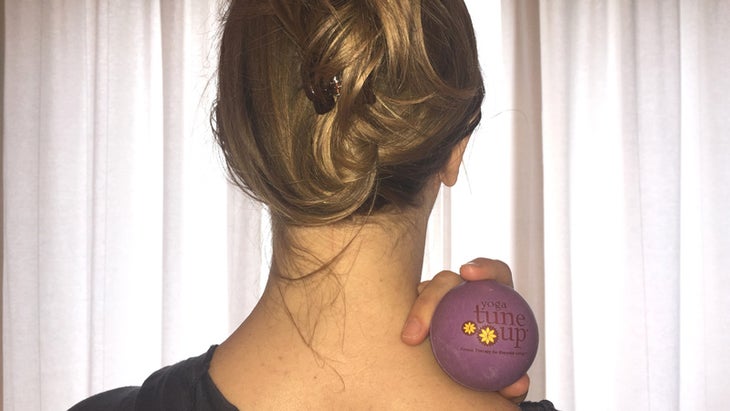
Many people carry shoulder tension in the trapezius muscles of the upper back. Tight “traps” and their connecting fascia can impact neck and shoulder position by contracting the chest and front body.
FIND IT The trapezius muscle is located on the back between the neck and outer shoulder. Begin on the part of the trap where you see the ball placed above.
See also Crick Fixes: Asana Sequences for Neck and Shoulder Pain
How to Release Your Traps
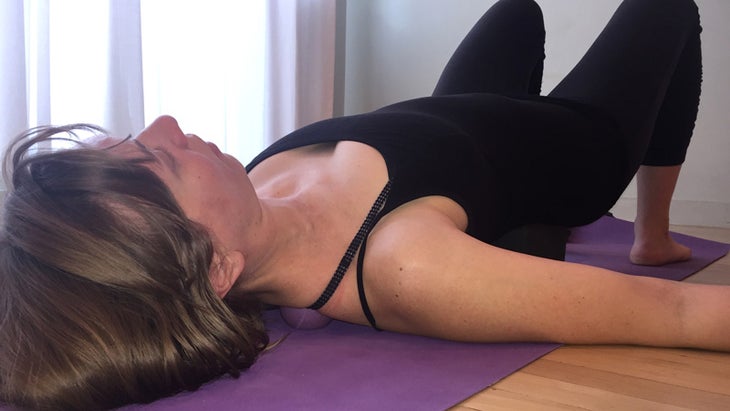
Step 1
Lie on your back with your knees bent. Place a ball under your right trapezius muscle. Take several rounds of deep breath here. If the sensation is too strong, consider padding the ball with a sock, or using another, hollower ball. Then switch sides.
See alsoFix the Slouch: 4 Poses for Upper-Crossed Syndrome
How to Release Your Traps
![2015-04-17_09.37.17[1] fascial release fascial release](https://cdn.yogajournal.com/wp-content/uploads/2015/04/2015-04-17_0937171-fascial-release.jpg?width=730)
Step 2
To increase sensation, lift your hips into Bridge Pose (you can place a block under your sacrum so the hamstrings remain relaxed). Breathe here for a few minutes, moving your body around slowly to help release the traps on all sides. When this feels complete to your body, remove the ball and enjoy a mini-Savasana to let your brain assimilate the pose. Repeat on the other side.
See alsoShoulder Tightness, Pain, or Injury? Here’s the Yoga that Helps
The Hotspot: Your Piriformis
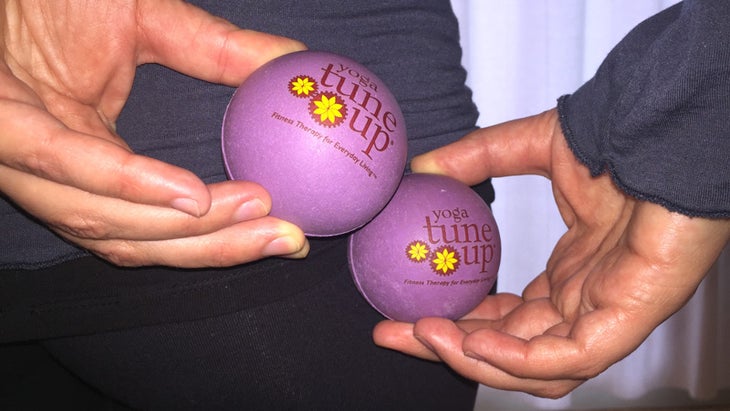
Many people carry tension in the piriformis muscles, which sit underneath the glutes. Tight piriformis muscles and fascia can cause strain in the hips, hamstrings, and lower back, and also affect the core body.
FIND IT Your piriformis is located deep underneath your gluteus maximus. When tight, it impacts the rotation of the hips, as well as the lower back and several other neighboring areas. It’s also said to have a strong relationship with the iliopsoas, or the front part of your hips. Locate the approximate location of the piriformis, where the balls are above.
See alsoIntro to Anatomy: Piriformis Primer
How to Release Your Piriformis
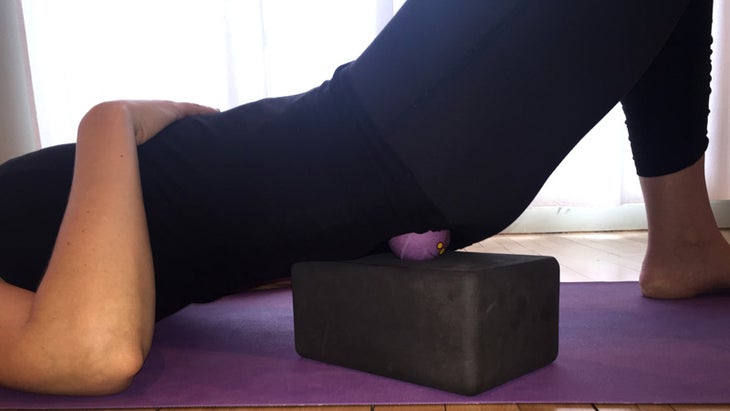
Step 1
Lie on your back with your knees bent. Place a block underneath your right butt cheek (that’s gluteus maximus for my fellow anatomy geeks). Sandwich two yoga therapy balls or tennis balls between your right butt cheek and the block, aiming for the center and lateral side of your butt cheek. Rest for several breaths before switching sides.
See alsoGlute Anatomy to Improve Your Practice
How to Release Your Piriformis
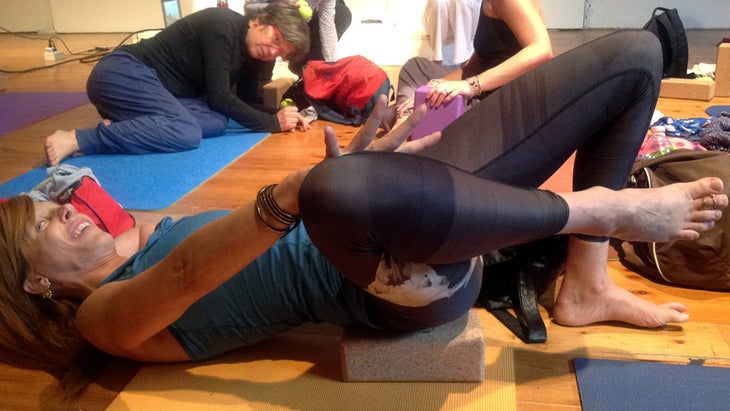
Step 2
Slowly lift up your right leg, keeping it bent, and begin to “play,” drawing small, slow circles in the air to reach different parts of the muscle and connective tissue. You can also place your right hand on the inside of your right knee and gently guide the leg further into external rotation. Less is more here. Make sure that you listen to your body and use the amount of stimulation that your body desires. Breathe deeply throughout. After a few minutes, you can switch to the other side. Finish by resting with your legs bent and your spine grounded on the mat.
See alsoHow to Loosen Up Your Lats
Like This Piece? You’ll Love YJ LIVE!

Get even more life-changing insights, techniques and practice enhancements from Bo Forbes at Yoga Journal LIVE! San Diego, June 24-27.
In “Cultivating Happiness,” Forbes will offer simple, science-based practices to balance anxiety, lift depression and cultivate stress resilience. Her “Connective Tissue Matrix” workshop will reveal the bond between your fascia and emotional issues like trauma, anxiety and depression—and give you the tools to relieve both. In “Body Maps,” her workshop on the brain’s mental representation of our body and our functions, are the key to healthy aging, pain management, and emotional balance. Finally, learn how to tap into a deep creative flow with “Yoga, Creativity, and the Body.”
Get the full descriptions of Bo Forbes’ events and sign up now.
About Bo Forbes

Bo Forbes is a clinical psychologist, a yoga teacher, and an integrative yoga therapist whose background includes training in biopsychology, behavioral medicine, sleep disorders, and stress management. She is the founder of Integrative Yoga Therapeutics, a system that specializes in the therapeutic application of yoga for anxiety, insomnia, depression, immune disorders, chronic pain, physical injuries, and athletic performance. Bo conducts teacher trainings and workshops internationally, writes frequently for Yoga Journal, Body + Soul, the International Journal of Yoga Therapy, and other leading magazines, and is on the advisory board of the International Association of Yoga Therapists and the Give Back Yoga Foundation. She is part of a research collaborative that investigates the contemplative practice of yoga, and will participate in the Mind and Life Institute’s Summer Research Institute this year. She is also the author of Yoga for Emotional Balance: Simple Practices to Relieve Anxiety and Depression. Learn more at boforbes.com and via Facebook, Twitter, and Instagram.
Pose model: Alison Sager